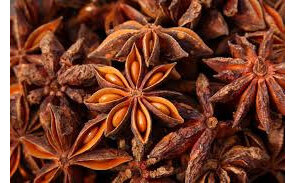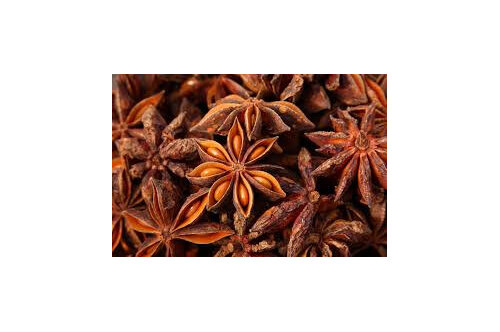Ingredient: Organic Whole Star Anise (Illicium verum)
Origin: China
Native to China and Vietnam, star anise is today grown almost exclusively in southern China, Indo-China, and Japan. Star anise, Illicium verum, is sometimes called Chinese star anise. It’s important to distinguish it from Japanese star anise, Illicium anisatum, which is highly toxic. Star anise is not related to the common anise, Anisum vulgare. It was first introduced into Europe in the seventeenth century. The oil, produced by a process of steam extraction, is substituted for European aniseed in commercial drinks.
Spice Description
Star anise is the unusual fruit of a small oriental tree. It is, as the name suggests, star shaped, radiating between five and ten pointed boat-shaped sections, about eight on average. These hard sections are seed pods. Tough skinned and rust coloured, they measure up to 3cm (1-1/4”) long. The fruit is picked before it can ripen, and dried. The stars are available whole, or ground to a red-brown powder.
Bouquet: Powerful and liquorice-like, more pungent and stronger than anise.
Flavour: Evocative of a bitter aniseed, of which flavour star anise is a harsher version. Nervertheless, the use of star anise ensures an authentic touch in the preparation of certain Chinese dishes.
Star anise is used in the East as aniseed is in the West. Apart from its use in sweetmeats and confectionery, where sweeteners must be added, it contributes to meat and poultry dishes, combining especially well with pork and duck.
In Chinese red cooking, where the ingredients are simmered for a lengthy period in dark soy sauce, star anise is nearly always added to beef and chicken dishes. Chinese stocks and soups very often contain the spice. It flavours marbled eggs, a decorative Chinese hors d’oeuvre or snack. Mandarins with jaded palates chew the whole dried fruit habitually as a post-prandial digestant and breath sweetener – an oriental comfit.
In the West, star anise is added in fruit compotes and jams, and in the manufacture of anise-flavoured liqueurs, the best known being anisette. It is an ingredient of the mixture known as “Chinese Five Spice”.
Star anise pairs brilliantly with tomatoes. It’s licorice-like flavor actually bears a close resemblance to that of fennel and basil, tomato’s classic companions. A single pod of star anise adds a new level of flavour to a tomato-based sauce or stew with a warm, spicy undertone. The same goes for braised beef dishes – from stews to chili to oxtail soup, star anise can be the secret ingredient that elevates the dish to a whole new level.
Substitute For Star Anise
Substitute fennel seed common anise or equal amounts of Chinese five spice powder.
Health Benefits of Star Anise
There are many possible health benefits to this product. To learn more research online.







